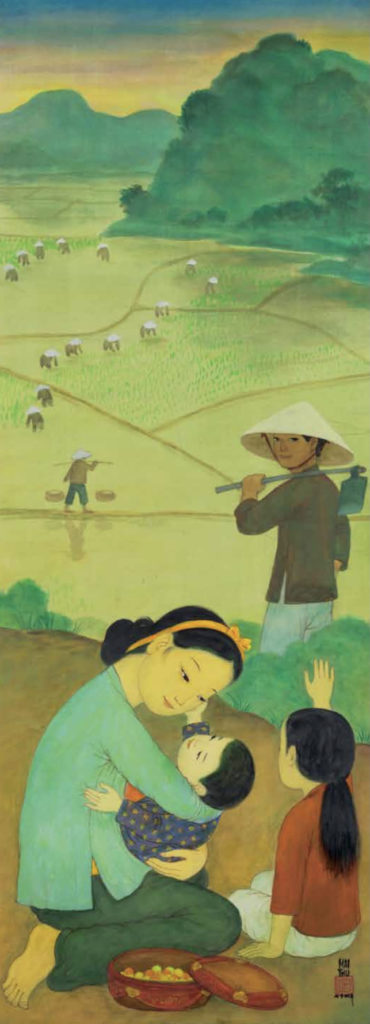Mai Thung Tru, « L’Aube Nouvelle », 1974, Or geography no longer makes history
The date and title of this large and unusual gouache and ink on silk can be explained:

In 1974, the defeat of the South against the North seemed to be inescapable. The previous year, the “Paris Accords” were ratified, enacting the military abandonment of the South by the US, while the efforts of the two “big communist brothers”, USSR and China, only intensified in the North. Mai Thu, who lived in France since 1937 and who only returned to Vietnam – on his way to Japan – once in 1962, was distressed about the situation in his native country. He never took sides (publicly) with any of the protagonists of the conflict but always denounced the horrors of war, a terrible purveyor of the most unjust deaths.
The title of the work L’Aube Nouvelle (The New Dawn) is significant. Indeed, it evokes the new dawn when the work in the rice field resumes, but also, in some way, the painter’s faith in a better world – a peaceful one – which could be announced with the end of hostilities.
The scene is set in Tonkin, indicated by a sugar loaf and in the background the first peaks of the Middle Region. The scene depicts a peasant woman in the foreground with children, next to a box filled with sweets or lotus seeds coated with sugar, strawberries or tamarind – sweets that are distributed during Têt, for which the little boy has been dressed in his best shirt.
The scene of departure is not embodied in the same way by the protagonists. The man walks away with a slightly frozen smile to greet the small group that seems to be his family. The woman, with a slightly worried face, only pays attention to her son in her arms, while the little
girl embodies the two flows of the work by waving. The work is not realistic in the context of great scarcity and great danger in the North in the year 1974. The artist has frozen a traditional scene from his youth, a scene that Nguyen Phan Chanh would not have disavowed.
The sky, at the very top, is brushed with warmer gouache pigments, like a symbol of eternal hope.
The rarity of the theme in Mai Thu’s work, the modesty of its treatment, the exceptionally large format ( 94 X 36 cm) the accuracy of the lines, the subtlety of the gouache tones and the solemn sobriety of the frame executed by Mai Thu himself, make L’Aube Nouvelle (The New Dawn) an important work in the artist’s production.
Jean-François Hubert